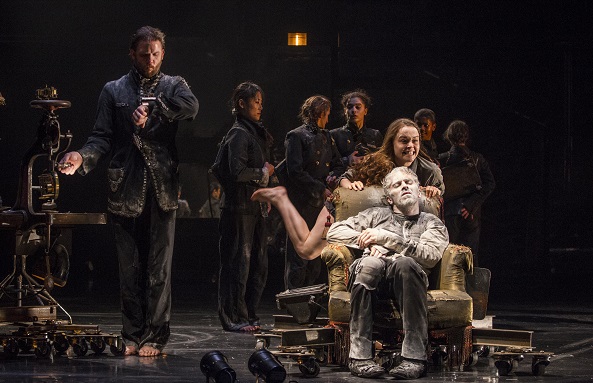Sydney Theatre
January 9, 2015
By Lynne Lancaster of Dance Informa.
The son of circus performers Victoria Chaplin and Jean-Baptiste Thiérrée, the grandson of filmmaker Charlie Chaplin, and the great-grandson of playwright Eugene O’Neill, James Thiérrée made his stage debut at the age of five and grew up in the world of European touring circuses. Now he is perhaps best known as a director of large-scale, free-form productions combining mime, acrobatics and dance. La Veillée des Abysses (2003) and Au Revoir Parapluie (2007) are probably his best known works. Sydney saw his Junebug Symphony in 2003.
His Tabac Rouge, a major event of this year’s Sydney Festival, was a strange, disturbing and challenging piece in every way, and can be classified perhaps as surrealist or “theatre of the absurd.” It’s heavy set with huge coils of electrical cords and giant emphatic lighting rigs are dominated by a fragmented, mouldy mirror as tall as the stage. This is pulled and pushed in circles, tilted and lifted into a horizontal position, lowered to become a second stage, finally “exploding” in fragments and “flying” in a visually stunning coup de theatre.
As in other Thiérrée works, huge blocks of scaffolding and mirrored sheeting are wheeled at great speed around and across the stage. Surrealist looking desks and sofas are piled high with books, papers and mid-20th-century office junk. Meanwhile, snatches of popular classics are played loudly and suddenly, confusingly interwoven with crackly radio recordings and electrical static. Dancers slide on their bellies, race around the stage and throw random shapes in the reflective mirrors and against the scaffolding.

‘Tabac Rouge’. Photo by Prudence Upton.
The amazing cast of nine performers sometimes do a slow-motion, arms-waving-like-tendrils-underwater like fragment of movement, accompanied by silent screams, or are perhaps on their back like a baby searching for and following the light. Sometimes they wear lampshades on their heads or dangerously hurl themselves at the scaffolding, which at times revolves, or they drape themselves over the scaffolding as if dead (think Les Mis) or are they? There is lots of rolling floor work. As in tempestuous King Lear, theirs is a scary world in which the power is held by a madman surrounded by acolytes, whose individual and collective actions, like the mirror, reflect his moods and desires as he controls and directs them like slithery puppets. There is a constant cascading rush of fractured, jagged movements that nonetheless coalesce into a sort of coherent, whirlwind whole, although nothing is at all clear.
At the central maelstrom of it all, like a rambunctious Lord of Misrule, is Thiérrée. Are we to imagine that he is a kind of Lear character, wandering in his broken kingdom? Or possibly Prospero, shorn of his magic? Remember that Thiérrée played the part of Ariel in Peter Greenaway’s 1991 film Prospero’s Books. He has an incredible boneless expression and body-shape-changing solo at one point. Or is he perhaps an escapee from Waiting for Godot? The overall format of the work is episodic in short, flowing scenes, but there is no real structural narrative. In the programme, Thiérrée doesn’t answer the question as to what the show is “about.” The governance of power is challenged, and perhaps shifts, but not for long. No one and nothing remains still. Everything is on wheels, even the performers at times. Chairs, an old sewing machine, a strange construction of electrical whatsists, a table loaded with props hurtle in and out.
Tabac Rouge offers a challenging whirlwind and a most unsettling performance.
Photo (top): Tabac Rouge. Photo by Jamie Williams.

















